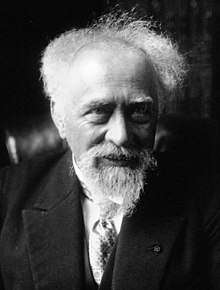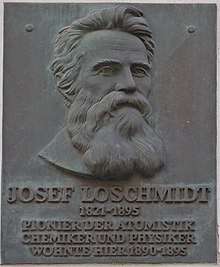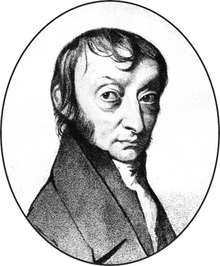Avogadro constant
The Avogadro constant (NA[1] or L[2]) is the proportionality factor that relates the number of constituent particles (usually molecules, atoms or ions) in a sample with the amount of substance in that sample. Its SI unit is the reciprocal mole, and it is defined as NA = 6.02214076×1023 mol−1.[3][1][4][5][6] It is named after the Italian scientist Amedeo Avogadro.[7]
The numeric value of the Avogadro constant expressed in reciprocal mole, a dimensionless number, is called the Avogadro number, sometimes denoted N[8][9] or N0,[10][11] which is thus the number of particles that are contained in one mole, exactly 6.02214076×1023.[4][1]
The value of the Avogadro constant was chosen so that the mass of one mole of a chemical compound, in grams, is numerically equal (for all practical purposes) to the average mass of one molecule of the compound, in daltons (universal atomic mass units); one dalton being 1/12 of the mass of one carbon-12 atom, which is approximately the mass of one nucleon (proton or neutron). For example, the average mass of one molecule of water is about 18.0153 daltons, and one mole of water (N molecules) is about 18.0153 grams. Thus, the Avogadro constant NA is the proportionality factor that relates the molar mass of a substance to the average mass of one molecule, and the Avogadro number is also the approximate number of nucleons in one gram of ordinary matter.[12]
The Avogadro constant also relates the molar volume of a substance to the average volume nominally occupied by one of its particles, when both are expressed in the same units of volume. For example, since the molar volume of water in ordinary conditions is about 18 mL/mol, the volume occupied by one molecule of water is about 18/6.022×10−23 mL, or about 30 Å3 (cubic angstroms). For a crystaline substance, it similarly relates its molar volume (in mL/mol), the volume of the repeating unit cell of the crystals (in mL), and the number of molecules in that cell.
The Avogadro number (or constant) has been defined in many different ways through its long history. Its approximate value was first determined, indirectly, by Josef Loschmidt in 1865.[13] (Avogadro's number is closely related to the Loschmidt constant, and the two concepts are sometimes confused.) It was initially defined by Jean Perrin as the number of atoms in 16 grams of oxygen.[7] It was later redefined in the 14th conference of the International Bureau of Weights and Measures (BIPM) as the number of atoms in 12 grams of the isotope carbon-12 (12C).[14] In each case, the mole was defined as the quantity of a substance that contained the same number of atoms as those reference samples. In particular, when carbon-12 was the reference, one mole of carbon-12 was exactly 12 grams of the element.
These definitions meant that the value of the Avogadro number depended on the experimentally determined value of the mass (in grams) of one atom of those elements, and therefore it was known only to a limited number of decimal digits. However, in its 26th Conference, the BIPM adopted a different approach: effective 20 May 2019, it defined the Avogadro number as the exact value N = 6.02214076×1023, and redefined the mole as the amount of a substance under consideration that contains N constituent particles of the substance. Under the new definition, the mass of one mole of any substance (including hydrogen, carbon-12, and oxygen-16) is N times the average mass of one of its constituent particles—a physical quantity whose precise value has to be determined experimentally for each substance.
History
Origin of the concept

The Avogadro constant is named after the Italian scientist Amedeo Avogadro (1776–1856), who, in 1811, first proposed that the volume of a gas (at a given pressure and temperature) is proportional to the number of atoms or molecules regardless of the nature of the gas.[15]
The name Avogadro's number was coined in 1909 by the physicist Jean Perrin, who defined it as the number of molecules in exactly 32 grams of oxygen.[7] The goal of this definition was to make the mass of a mole of a substance, in grams, be numerically equal to the mass of one molecule relative to the mass of the hydrogen atom; which, because of the law of definite proportions, was the natural unit of atomic mass, and was assumed to be 1/16 of the atomic mass of oxygen.
First measurements

The value of Avogadro's number (still not known by that name) was first obtained indirectly by Josef Loschmidt in 1865, by estimating the number of particles in a given volume of gas.[13] This value, the number density n0 of particles in an ideal gas, is now called the Loschmidt constant in his honor, and is related to the Avogadro constant, NA, by
where p0 is the pressure, R is the gas constant, and T0 is the absolute temperature. Because of this work, the symbol L is sometimes used for the Avogadro constant,[16] and, in German literature, that name may be used for both constants, distinguished only by the units of measurement.[17] (However, NA should not to be confused with the entirely different Loschmidt constant in the English language literature.)
Perrin himself determined Avogadro's number by several different experimental methods. He was awarded the 1926 Nobel Prize in Physics, largely for this work.[18]
The electric charge per mole of electrons is a constant called the Faraday constant and had been known since 1834 when Michael Faraday published his works on electrolysis. In 1910, Robert Millikan obtained the first measurement of the charge on an electron. Dividing the charge on a mole of electrons by the charge on a single electron provided a more accurate estimate of the Avogadro number.[19]
SI definition of 1971
In 1971 the International Bureau of Weights and Measures (BIPM) decided to regard the amount of substance as an independent dimension of measurement, with the mole as its base unit in the International System of Units (SI).[16] Specifically, the mole was defined as an amount of a substance that contains as many elementary entities as there are atoms in 0.012 kilogram of carbon-12.
By this definition, the common rule of thumb "one gram of matter contains N0 nucleons" was exact for carbon-12, but slightly inexact for other elements and isotopes. On the other hand, one mole of any substance contained exactly as many molecules as one mole of any other substance.
As a consequence of this definition, in the SI system the Avogadro constant NA had the dimensionality of reciprocal of amount of substance rather than of a pure number, and had the approximate value 6.02×1023 with units of mol−1.[16] By this definition, the value of NA inherently had to be determined experimentally.
The IBPM also named NA the "Avogadro constant", but the term "Avogadro number" continued to be used especially in introductory works.[20]
SI redefinition of 2019
In 2017, the IBPM decided to change the definitions of mole and amount of substance.[21][4] The mole was redefined as being the amount of substance containing exactly 6.02214076×1023 elementary entities. One consequence of this change is that the mass of a mole of 12C atoms is no longer exactly 0.012 kg. On the other hand, the dalton (a.k.a. universal atomic mass unit) remains unchanged as 1/12 of the mass of 12C.[22][23] Thus, the molar mass constant is no longer exactly 1 g/mol, although the difference (3.5×10−10 in relative terms, as of March 2019) is insignificant for practical purposes.[4]
The Avogadro constant in other unit systems
In other measurement systems where the unit of amount of substance is not the SI mole, the Avogadro constant NA is taken to mean the number of particles in said unit, and will have a different value.
For example, if quantities of a substance are measured in pound-mole (lb-mol), then the Avogadro constant NA is 2.73159734(12)×1026 lb-mol−1. If the ounce-mole (oz-mol) is used instead, NA is 1.707248434(77)×1025 oz-mol−1. However, these units are hardly used nowadays.
Connection to other constants
The Avogadro constant, NA is related to other physical constants and properties.
- It relates the molar gas constant R and the Boltzmann constant kB, which in the SI (since 20 May 2019) is defined to be exactly 1.380649×10−23 J/K:[4]
- = 8.31446261815324 J⋅K−1⋅mol−1
- It relates the Faraday constant F and the elementary charge e, which in the SI (since 20 May 2019) is defined as exactly 1.602176634×10−19 coulombs:[4]
- = 96485.3321233100184 C/mol
- It relates the molar mass constant, Mu and the atomic mass constant mu, currently 1.66053906660(50)×10−27 kg:[24]
- = 0.99999999965(30)×10−3 kg⋅mol−1[25]
See also
- Mole Day
- CODATA 2018
References
- Bureau International des Poids et Mesures (2019): The International System of Units (SI), 9th edition, English version, page 134. Available at the BIPM website.
- H. P. Lehmann, X. Fuentes-Arderiu, and L. F. Bertello (1996): "Glossary of terms in quantities and units in Clinical Chemistry (IUPAC-IFCC Recommendations 1996)"; page 963, item "Avogadro constant". Pure and Applied Chemistry, volume 68, issue 4, pages 957–1000. doi:10.1351/pac199668040957
- "2018 CODATA Value: Avogadro constant". The NIST Reference on Constants, Units, and Uncertainty. NIST. 20 May 2019. Retrieved 2019-05-20.
- International Bureau for Weights and Measures (2018): Resolutions Adopted - 26th Confernce Générale des Poids et Mesures Archived 2018-11-19 at the Wayback Machine. Available at the BIPM website.
- IUPAC, Compendium of Chemical Terminology, 2nd ed. (the "Gold Book") (1997). Online corrected version: (2006–) "Avogadro constant". doi:10.1351/goldbook.A00543
- de Bievre, P.; Peiser, H. S. (1992). "Atomic Weight: The Name, Its History, Definition and Units". Pure and Applied Chemistry. 64 (10): 1535–1543. doi:10.1351/pac199264101535.
- Perrin, Jean (1909). "Mouvement brownien et réalité moléculaire". Annales de Chimie et de Physique. 8e Série. 18: 1–114. Extract in English, translation by Frederick Soddy.
- Linus Pauling (1970), General Chemistry, page 96. Dover Edition, reprinted by Courier in 2014; 992 pages. ISBN 9780486134659
- Marvin Yelles (1971): McGraw-Hill Encyclopedia of Science and Technology, Volume 9, 3rd edition; 707 pages. ISBN 9780070797987
- Richard P. Feynman (1963): The Feynman Lectures on Physics, Volume II, 2nd edition; 512 pages. ISBN 9780805390476
- Max Born (1969): Atomic Physics, 8th Edition. Dover edition, reprinted by Courier in 2013; 544 pages. ISBN 9780486318585
- Okun, Lev B.; Lee, A. G. (1985). Particle Physics: The Quest for the Substance of Substance. OPA Ltd. p. 86. ISBN 978-3-7186-0228-5.
- Loschmidt, J. (1865). "Zur Grösse der Luftmoleküle". Sitzungsberichte der Kaiserlichen Akademie der Wissenschaften Wien. 52 (2): 395–413. English translation.
- International Bureau of Weights and Measures (2006), The International System of Units (SI) (PDF) (8th ed.), pp. 114–15, ISBN 92-822-2213-6, archived (PDF) from the original on 2017-08-14
- Avogadro, Amedeo (1811). "Essai d'une maniere de determiner les masses relatives des molecules elementaires des corps, et les proportions selon lesquelles elles entrent dans ces combinaisons". Journal de Physique. 73: 58–76. English translation.
- Bureau International des Poids et Mesures (1971): 14th Conference Générale des Poids et Mesures Available at the BIPM website.
- Virgo, S.E. (1933). "Loschmidt's Number". Science Progress. 27: 634–649. Archived from the original on 2005-04-04.
- Oseen, C.W. (December 10, 1926). Presentation Speech for the 1926 Nobel Prize in Physics.
- (1974): Introduction to the constants for nonexperts, 1900–1920 From the Encyclopaedia Britannica, 15th edition; reproduced by NIST. Accessed on 2019-07-03.
- Kotz, John C.; Treichel, Paul M.; Townsend, John R. (2008). Chemistry and Chemical Reactivity (7th ed.). Brooks/Cole. ISBN 978-0-495-38703-9. Archived from the original on 2008-10-16.
- International Bureau for Weights and Measures (2017): Proceedings of the 106th meeting of the International Committee for Weights and Measures (CIPM), 16-17 and 20 October 2017, page 23. Available at the BIPM website.
- Pavese, Franco (January 2018). "A possible draft of the CGPM Resolution for the revised SI, compared with the CCU last draft of the 9th SI Brochure". Measurement. 114: 478–483. doi:10.1016/j.measurement.2017.08.020. ISSN 0263-2241.
- Lehmann, H. P.; Fuentes-Arderiu, X.; Bertello, L. F. (2016-02-29). "Unified Atomic Mass Unit". doi:10.1515/iupac.68.2930. Cite journal requires
|journal=(help) - "2018 CODATA Value: atomic mass constant". The NIST Reference on Constants, Units, and Uncertainty. NIST. 20 May 2019. Retrieved 2019-05-20.
- "2018 CODATA Value: molar mass constant". The NIST Reference on Constants, Units, and Uncertainty. NIST. 20 May 2019. Retrieved 2019-05-20.
External links
- 1996 definition of the Avogadro constant from the IUPAC Compendium of Chemical Terminology ("Gold Book")
- Some Notes on Avogadro's Number, 6.022×1023 (historical notes)
- An Exact Value for Avogadro's Number – American Scientist
- Avogadro and molar Planck constants for the redefinition of the kilogram
- Murrell, John N. (2001). "Avogadro and His Constant". Helvetica Chimica Acta. 84 (6): 1314–1327. doi:10.1002/1522-2675(20010613)84:6<1314::AID-HLCA1314>3.0.CO;2-Q.
- Scanned version of "Two hypothesis of Avogadro", 1811 Avogadro's article, on BibNum
